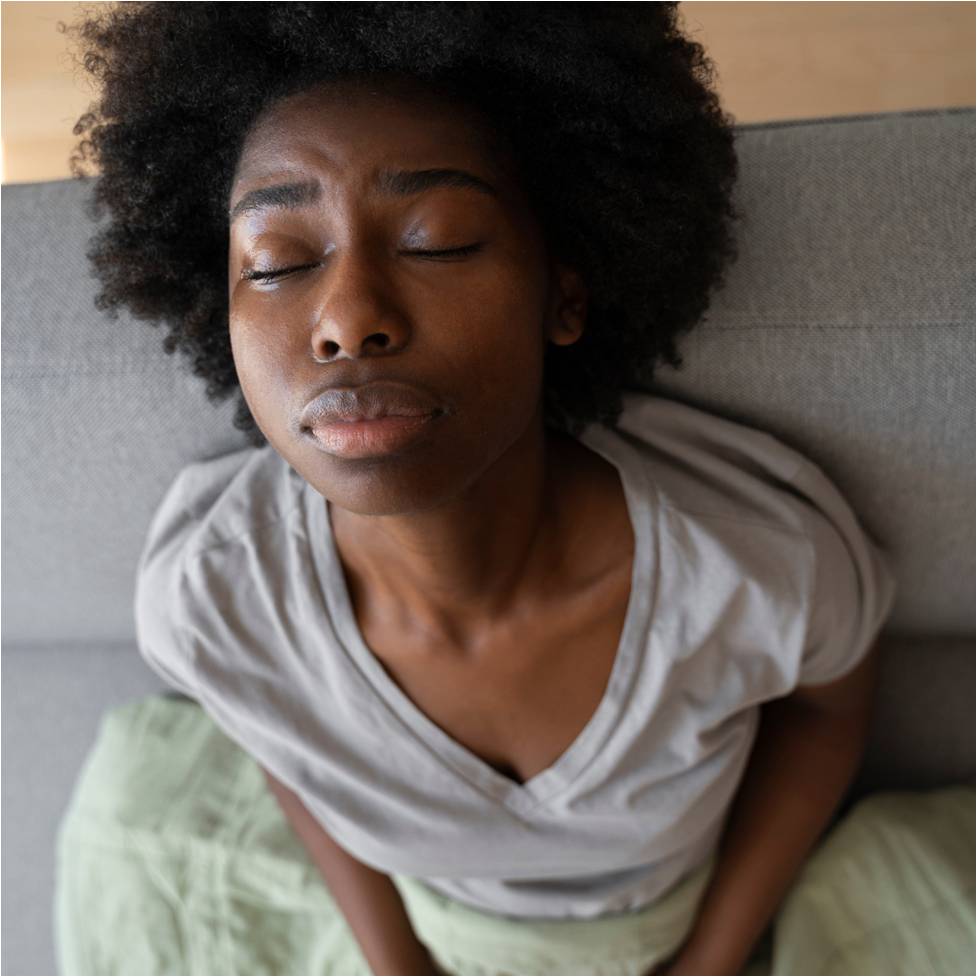By: Dr Temitope Oyetunji MBBS, FWACP (Family Medicine). Medically reviewed by: Dr. Azuka Ezeike, MBBS, FWACS (Obstetrics and Gynaecology), FMCOG, MSc (Public Health).

An African female sitting with eyes closed, looking distressed due to period pain. Designed by Freepik
Menstruation is often described as a "monthly affair" or a "monthly visitor" in many traditional African cultures, highlighting its routine nature in women's lives. However, this monthly affair should not be accompanied by debilitating pain. Effective treatment for period pain is therefore crucial, as untreated pain can significantly disrupt women’s daily activities and lower their quality of life.
This article focuses on practical, medical and non-medical treatment of period pain in African females. It also explores the challenges of period pain treatment in the African setting.
Period pain (dysmenorrhoea) refers to painful menstruation. It is a very common problem for women all over the world, and African women are no exception. It affects between 51.1-88.1% of females in sub-Saharan Africa. [1]
For some women, period pain is a minor inconvenience, but for others, it can severely disrupt daily activities, work, and overall quality of life.
Research consistently highlights the significant impact of menstrual pain on women's productivity and well-being. Ensuring access to effective treatments can help shift this situation empowering women to lead healthier, more productive lives.
The treatment approach for period pain largely depends on whether the pain is grouped as primary or secondary.
This is the most common type of period pain, caused by contraction (tightening) of the uterus during menstruation. It is not linked to any underlying medical condition. [2]
Treatment for primary period pain often focuses on symptom relief and may include lifestyle changes, home remedies and medications.
Secondary period pain or dysmenorrhoea
For secondary period pain, there is an underlying cause which could be a pelvic abnormality or a medical condition, such as endometriosis, fibroids, or pelvic inflammatory disease (PID). [2]
In these cases, managing period pain involves a combination of symptom relief and addressing the root cause. Treatment options may include the use of medications like pain relievers, hormonal contraceptives or surgery.
If you complain of period pain, your healthcare provider will take a detailed history and evaluate you to determine whether your period pain is primary or secondary. This is crucial as it helps your healthcare provider to tailor your treatment for effective and lasting relief of your pain. [2, 3]
The treatment of primary and secondary dysmenorrhoea or period pain usually starts the same way. It includes educating women about the cause of the pain they are experiencing, reassuring them, providing supportive care, and using medications.
If these initial treatments do not relieve the symptoms, further tests may be needed to check for underlying conditions causing secondary dysmenorrhoea or period pain.
Generally, there are several treatment options available for treating period pain or dysmenorrhoea.
These include:
Lifestyle changes can be an effective way to manage period pain. [4-8] These can significantly alleviate period pain and improve overall well-being.
These lifestyle changes include:
Regular moderate-intensity physical exercise such as brisk walking or jogging is recommended to reduce period pain or dysmenorrhoea. Engaging in 50 minutes of exercise at least thrice a week is recommended to positively impact women experiencing painful menstrual periods. [2, 3, 8]
These activities improve blood flow in the pelvis and stimulate the release of chemical substances called endorphins, which act as natural pain relievers.
Low-intensity exercises like yoga and stretching have also shown consistent positive benefits for period pain reduction. [2, 7, 8]
These changes are beneficial in decreasing the risk of period pain. [7]
Various home remedies have been suggested for treating period pain. While research on some of these methods is inconclusive, many women have found them helpful in managing discomfort. They can either be used alone (alternative therapy) or in combination with medications (complementary therapy).
One advantage of these remedies is their affordability, especially for women from low-income households.
Some of these home remedies include:
Applying heat to the lower abdomen is a simple and effective way to relieve period pain. Some studies suggest it works as well as pain relievers like non-steroidal anti-inflammatory drugs (NSAIDs) and even better than acetaminophen (paracetamol). [2, 3]
This method is popular among many women because it is natural and does not have side effects. A heating pad, hot water bottle, or even warm water in a container can be used to soothe period pain.
Many women, especially in regions like Africa and Asia, turn to herbal remedies for relief from period pain. Herbs like ginger, chamomile, cinnamon, and fennel are often recommended for their potential pain-relieving effects. [7]
However, the scientific evidence supporting the effectiveness of these remedies is still debated, and more research is needed to confirm their benefits. [7]
It should be of no surprise that in some African communities, the use of herbal remedies is preferred over modern medications due to concerns about the cost and side effects of orthodox medicines. [5]
These techniques include deep breathing exercises, meditation, mindfulness and aromatherapy massage, particularly with essential oils like lavender. [5-8]
They work by reducing stress and altering the perception of pain. Studies have found that they provide relief for menstrual cramps. [6, 8]
For African females experiencing moderate to severe menstrual pain, medications can provide effective relief.

An amber-colored bottle lying on its side against a bright yellow background, with colorful capsules spilling out. Designed by Freepik
Currently, medications remain the most reliable and effective option for relieving menstrual pain or dysmenorrhoea. [4]
Several classes of drugs can be used in the treatment of period pain. Some of these medications can be bought over the counter from medicine stores. They include:
They work by blocking certain enzymes in the body that produce prostaglandins (chemicals made in the lining of the womb). These prostaglandins are responsible for triggering the pain associated with period cramps.
To get the best results from NSAIDs, they should be taken 1 to 2 days before the onset of menstruation. They should be taken with food to reduce the risk of stomach upset and continued for the first 2 to 3 days of menstruation. [2, 3]
Hormonal Contraceptives (birth control)
These are especially useful in women with period pain who do not wish to conceive. Agents used include:
They work by suppressing ovulation and thinning the lining of the womb. This results in reduced production of prostaglandins and reduced pain. [2-4] These hormonal agents are usually prescribed by healthcare providers.
Other hormonal treatments that doctors may recommend include medications like danazol and GnRH analogues, which help manage period pain by controlling hormone levels in the body.
In cases where period pain is caused by underlying conditions such as endometriosis or fibroids, surgery may be necessary.
Surgeries that may be carried out include:
It is crucial to seek medical advice when period pain significantly disrupts your daily life or does not respond to self-care and over-the-counter medications. You should seek medical evaluation if period pain lasts more than 3-4 days.
If you have other symptoms like heavy or irregular periods or pelvic pain outside of menstruation, you should also seek medical advice.
Healthcare providers can identify underlying issues and recommend personalized treatment plans tailored to your symptoms and medical history.
Accessing effective medical treatment for period pain in Africa is hindered by:
Menstrual health is shrouded in stigma and cultural misconceptions. Lack of, or poor awareness about menstrual health often results in delayed care as many women consider period pain a ‘normal’ part of womanhood. Some others believe that medications used in treating period pain may be harmful. Such women choose instead to suffer in silence or rely on traditional remedies.
Without health insurance coverage for women's health issues, financial challenges can become a major barrier. Many women must pay for consultations and treatments out of pocket, which can be expensive, especially for low-income households.
Many women, especially those in rural areas face significant challenges when it comes to accessing healthcare for period pain. These challenges include the lack of nearby healthcare facilities, making it difficult to get professional medical attention. Even when available, facilities are often poorly equipped due to inadequate infrastructure, frequent shortages of essential medications, and a lack of skilled medical professionals to provide proper care.
Period pain, while common, should not be accepted as a normal or inevitable part of life for women. With proper awareness and effective treatment, women can regain control over their menstrual health and lead pain-free, productive lives.
In Africa, addressing the unique challenges of managing period pain requires a collaborative approach. This includes providing education to dispel misconceptions about menstruation, improving healthcare access, ensuring the availability of essential medicines, and alleviating financial barriers through social health insurance. By empowering women with knowledge about the treatment options for period pain, we can transform how period pain is perceived and managed, ensuring no woman has to suffer in silence.
1. Mammo M, Alemayehu M, Ambaw G. Prevalence of primary dysmenorrhea, its intensity and associated factors among female students at high schools of Wolaita zone, Southern Ethiopia: cross-sectional study design. Inter J Womens Health. 2022 Nov 9;4:1569–77. Doi: 10.2147/IJWH.S384275. Available from here.
2. Nagy H, Carlson K, Khan MA. Dysmenorrhea. In: StatPearls [Internet]. Treasure Island (FL): StatPearls Publishing; 2024 [Last reviewed: Nov. 12, 2023]. Cited 2024 Dec 29. Available from here.
3. Itani R, Soubra L, Karout S, Rahme D, Karout L, Khojah HMJ. Primary dysmenorrhea: pathophysiology, diagnosis, and treatment updates. Korean J Fam Med 2022 Mar;43(2):101–8. doi: 10.4082/kjfm.21.0103. Available from here.
4. Dong A. Dysmenorrhea Treatment & Management. [Internet] Medscape. Updated August 1, 2024. [Cited 2024 Dec 29]; Available from here.
5. Cherenack EM, Rubli J, Melara A, Ezaldein N, King A, Alcaide ML, et al. Adolescent girls’ descriptions of dysmenorrhea and barriers to dysmenorrhea management in Moshi, Tanzania: A qualitative study. PLOS Glob Public Health. 2023 Jul 6;3(7):e0001544. doi: 10.1371/journal.pgph.0001544. Available from here.
6. Esan DT, Ariyo SA, Akinlolu EF, Akingbade O, Olabisi OI, Olawade DB, et al. Prevalence of dysmenorrhea and its effect on the quality of life of female undergraduate students in Nigeria. Journal of Endometriosis and Uterine Disorders. 2024;5:100059. doi.org/10.1016/j.jeud.2024.100059. Available from here.
7. Tsonis O, Gkrozou F, Barmpalia Z, Makopoulou A, Siafaka V. Integrating lifestyle focused approaches into the management of primary dysmenorrhea: impact on quality of life. Int J Womens Health. 2021 Mar 17;13:327–336. doi: 10.2147/IJWH.S264023. Available from here.
8. Armour M, Smith CA, Steel KA, Macmillan F. The effectiveness of self-care and lifestyle interventions in primary dysmenorrhea: a systematic review and meta-analysis. BMC Complementary and Alternative Medicine. 2019 Jan 17;19(1):22. Doi: 10.1186/s12906-019-2433-8. Available from here.
Related:
Period Pain in African Females: Types, Causes and Symptoms
Menstrual Health Issues in sub-Saharan Africa: An Overview
Endometriosis: What you need to know
Fibroid: What Every African Woman Should Know
Published: January 13, 2025
© 2025. Datelinehealth Africa Inc. All rights reserved.
Permission is given to copy, use and share content for non-commercial purposes without alteration or modification and subject to source attribution.
DATELINEHEALTH AFRICA INC., is a digital publisher for informational and educational purposes and does not offer personal medical care and advice. If you have a medical problem needing routine or emergency attention, call your doctor or local emergency services immediately, or visit the nearest emergency room or the nearest hospital. You should consult your professional healthcare provider before starting any nutrition, diet, exercise, fitness, medical or wellness program mentioned or referenced in the DatelinehealthAfrica website. Click here for more disclaimer notice.